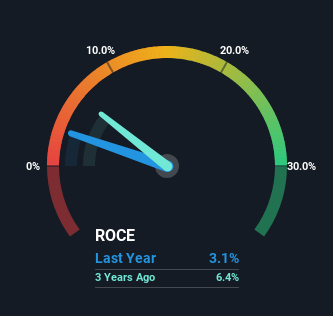- United States
- /
- Specialty Stores
- /
- NYSE:KMX
There Are Reasons To Feel Uneasy About CarMax's (NYSE:KMX) Returns On Capital
What are the early trends we should look for to identify a stock that could multiply in value over the long term? Amongst other things, we'll want to see two things; firstly, a growing return on capital employed (ROCE) and secondly, an expansion in the company's amount of capital employed. Basically this means that a company has profitable initiatives that it can continue to reinvest in, which is a trait of a compounding machine. Although, when we looked at CarMax (NYSE:KMX), it didn't seem to tick all of these boxes.
Return On Capital Employed (ROCE): What Is It?
If you haven't worked with ROCE before, it measures the 'return' (pre-tax profit) a company generates from capital employed in its business. The formula for this calculation on CarMax is:
Return on Capital Employed = Earnings Before Interest and Tax (EBIT) ÷ (Total Assets - Current Liabilities)
0.031 = US$789m ÷ (US$27b - US$2.2b) (Based on the trailing twelve months to February 2025).
Thus, CarMax has an ROCE of 3.1%. Ultimately, that's a low return and it under-performs the Specialty Retail industry average of 13%.
Check out our latest analysis for CarMax

Above you can see how the current ROCE for CarMax compares to its prior returns on capital, but there's only so much you can tell from the past. If you're interested, you can view the analysts predictions in our free analyst report for CarMax .
What Can We Tell From CarMax's ROCE Trend?
On the surface, the trend of ROCE at CarMax doesn't inspire confidence. Around five years ago the returns on capital were 6.3%, but since then they've fallen to 3.1%. However it looks like CarMax might be reinvesting for long term growth because while capital employed has increased, the company's sales haven't changed much in the last 12 months. It's worth keeping an eye on the company's earnings from here on to see if these investments do end up contributing to the bottom line.
The Key Takeaway
Bringing it all together, while we're somewhat encouraged by CarMax's reinvestment in its own business, we're aware that returns are shrinking. And in the last five years, the stock has given away 13% so the market doesn't look too hopeful on these trends strengthening any time soon. All in all, the inherent trends aren't typical of multi-baggers, so if that's what you're after, we think you might have more luck elsewhere.
On a final note, we've found 1 warning sign for CarMax that we think you should be aware of.
While CarMax may not currently earn the highest returns, we've compiled a list of companies that currently earn more than 25% return on equity. Check out this free list here.
New: AI Stock Screener & Alerts
Our new AI Stock Screener scans the market every day to uncover opportunities.
• Dividend Powerhouses (3%+ Yield)
• Undervalued Small Caps with Insider Buying
• High growth Tech and AI Companies
Or build your own from over 50 metrics.
Have feedback on this article? Concerned about the content? Get in touch with us directly. Alternatively, email editorial-team (at) simplywallst.com.
This article by Simply Wall St is general in nature. We provide commentary based on historical data and analyst forecasts only using an unbiased methodology and our articles are not intended to be financial advice. It does not constitute a recommendation to buy or sell any stock, and does not take account of your objectives, or your financial situation. We aim to bring you long-term focused analysis driven by fundamental data. Note that our analysis may not factor in the latest price-sensitive company announcements or qualitative material. Simply Wall St has no position in any stocks mentioned.
About NYSE:KMX
CarMax
Through its subsidiaries, operates as a retailer of used vehicles and related products in the United States.
Proven track record with mediocre balance sheet.
Similar Companies
Market Insights
Community Narratives





